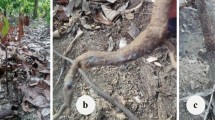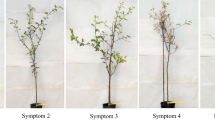Abstract
In the root rot complex in crocus, three different causes have been identified. Under conditions prevailing in The Netherlands, free-living nematodes (Pratylenchus penetrans andP. pratensis) seem to be of minor importance. The present study has shown that roots are incidentally invaded byStromatinia gladioli; the corms and leaf-sheaths appear to be less susceptible to this pathogen. Crocus is often planted in soil known to be contaminated by this fungus. It is not clear why root rot can only occasionally be ascribed to this cause. Further results indicate thatPythium spp. play a major part in the development of root rot.
Samenvatting
Minstens drie pathogenen kunnen aanleiding geven tot de vorming van wortelrot in krokussen. Slootweg noemt in dit verbandPratylenchus penetrans enP. pratensis; onder de cultuuromstandigheden in Nederland, waar veel gronden gebruikt voor de krokuscultuur regelmatig worden ontsmet met nematiciden (dichloorpropaan/dichloorpropeen of metam-natrium), speelt deze oorzaak een ondergeschikte rol.
Door middel van inoculatieproeven werd aangetoond datStromatinia gladioli, de verwekker van het droogrot in gladiolen, de wortels van krokussen ernstig kan aantasten (Fig. 1). De knollen en bladscheden blijken veel minder vatbaar te zijn dan de wortels. In de praktijk worden krokussen dikwijls geplant op grond, die door intensieve teelt van galdiolen ernstig besmet is geraakt door deze schimmel. Het is nog niet duidelijk waarom slechts in enkele gevallen van wortelrot een verband metS. gladioli kon worden aangetoond. Mogelijk wordt in een later stadium (wanneer bovengronds symptomen worden waargenomen) de aantasting in de wortels gemakkelijk gemaskeerd door opvallender beelden veroorzaakt doorPythium.
Nader onderzoek wees uit, dat nog niet nader gedetermineerde schimmels uit het geslachtPythium ook wortelrot tot stand kunnen brengen (Fig. 2). Ernstige schade in de praktijk komt meestal door deze oorzaak tot stand.
Similar content being viewed by others
References
Boerema, G. H., 1961. Aantekeningen over enkele niet algemeen voorkomende schimmelaantastingen bij bloembolgewassen. Versl., Meded. pl. ziektenk. Dienst Wageningen. 135 (Jaarb. 1960): 179–182.
Magie, R. O., 1954. Stromatinia disease of Gladiolus. Fla St. hort. Soc. Q. 7: 313–317.
Magie, R. O., 1956. Gladiolus Stromatinia disease controlled by soil treatments and cultural methods. (Abstr.) Phytopathology 46: 19.
Moore, W. C., 1939. Diseases of bulbs Bull. Minist. Agric. Fish. 117.
Plaats-Niterink, A. J. van der, 1968. The occurrence of Pythium in The Netherlands. I. Heterothallic species. Acta bot. neerl. 17: 320–329.
Saaltink, G. J., 1969. Root rot of hyacinths caused by species of Pythium. Neth. J. Pl. Path. 75: 343–354.
Schenk, P. K., 1961. De bestrijding van droogrot (Stromatinia gladioli (Drayt.) Whetz.) in gladiolen. Weekbl. BloembollCult. 72: 448–449.
Slootweg, A. F. G., 1956. Rootrot of bulbs caused by Pratylenchus and Hoplolaimus spp. Nematologica 1: 192–201.
Tomlinson, J. A., 1952. Root rot of crocus caused by Pythium ultimum. Pl. Path. 1: 50.
Author information
Authors and Affiliations
Rights and permissions
About this article
Cite this article
Schenk, P.K. Root rot in crocus. Netherlands Journal of Plant Pathology 76, 159–164 (1970). https://doi.org/10.1007/BF01974324
Accepted:
Issue Date:
DOI: https://doi.org/10.1007/BF01974324




